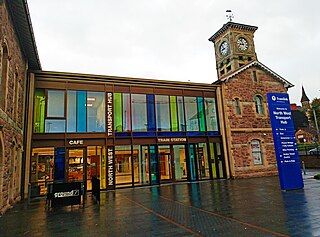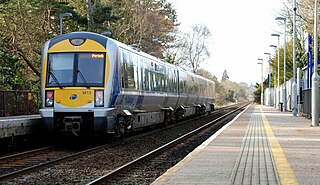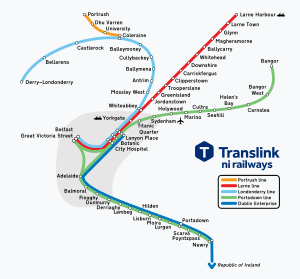
NI Railways, also known as Northern Ireland Railways, is the railway operator in Northern Ireland. NIR is a subsidiary of Translink, whose parent company is the Northern Ireland Transport Holding Company (NITHCo), and is one of nine publicly owned train operators in the United Kingdom, the others being Direct Rail Services, Caledonian Sleeper, Northern Trains, Transport for Wales Rail, Southeastern, LNER, ScotRail, and TransPennine Express. It has a common Board of Management with the other two companies in the group, Ulsterbus and Metro.

Rail transport in Ireland is provided by Iarnród Éireann in the Republic of Ireland and by Northern Ireland Railways in Northern Ireland.

Translink is the brand name of the Northern Ireland Transport Holding Company (NITHCo), a public corporation providing public transport in Northern Ireland. NI Railways, Ulsterbus, Goldliner, Metro and Glider are all part of Translink. It is led by CEO Chris Conway.

Enterprise is the cross-border inter-city train service between Dublin Connolly in the Republic of Ireland and Belfast Grand Central in Northern Ireland, jointly operated by Iarnród Éireann (IÉ) and NI Railways (NIR). It operates on the Belfast–Dublin railway line.

Belfast Lanyon Place is a railway station serving the city of Belfast in Northern Ireland. Located on East Bridge Street in the Laganside area of central Belfast, it is one of four stations in the city centre, the others being City Hospital, Botanic, and Belfast Grand Central.

Derry ~ Londonderry railway station, also known as North West Transport Hub or Waterside railway station, is a railway terminus in Derry, Northern Ireland, on the east bank of the River Foyle, operated by Northern Ireland Railways and its 7th busiest station across the network with 952,126 passengers boarding or alighting at the station in the 2023/24 financial year. It is on the Belfast–Derry railway line, terminating at Belfast Grand Central. Derry/Londonderry has the longest platforms on the NIR Network, at 258.3 metres in length.

Lisburn railway station serves the city of Lisburn in County Antrim, Northern Ireland.

The Belfast–Newry line operates from Belfast Grand Central in County Antrim to Newry in County Down, Northern Ireland. The manager for this line is based at Portadown railway station, although the line extends to the border to include the Scarva and Poyntzpass halts and Newry. Newry is on the fringe of the network, being the last stop before the border with the Republic of Ireland. The line follows the route of the northern half of the main Dublin–Belfast line.

Antrim railway station opened 1848 and serves the town of Antrim in County Antrim, Northern Ireland.

The Belfast to Bangor line is a railway line in Northern Ireland, originally part of the Belfast & County Down Railway. All services are operated by NI Railways, the only operator for Northern Ireland (NI). Unlike the rest of the United Kingdom, no railway in NI is part of the National Rail network and none is owned by Network Rail. Services run every half-hour, with up to six trains per hour in each direction at peak times.

The Belfast–Derry line is an intercity railway line, running from Belfast to Derry in Northern Ireland.

The Belfast–Dublin Line is the busiest railway route on the island of Ireland, connecting Dublin Connolly station in the Republic of Ireland and Belfast Grand Central station in Northern Ireland. It is the only railway line that crosses the Republic of Ireland–United Kingdom border.

Portadown Railway Station serves the town of Portadown in County Armagh, Northern Ireland.

Newry railway station serves Newry and Bessbrook in Northern Ireland. The station is located in the northwest of Newry, County Armagh on the Dublin-Belfast line close to the Craigmore Viaduct. It is the most southerly railway station in Northern Ireland.

Moira railway station serves Moira in County Down, Northern Ireland. Despite the station serving the County Down town, the station itself is located in County Antrim, the neighbouring Lagan Canal being the boundary. Moira station is the oldest building on the NI Railways network today having been opened on 18 November 1841. The old, now redundant, signal box stands over the station on the Southbound side.

Lurgan railway station serves Lurgan in County Armagh, Northern Ireland. Located on William Street. The station is managed by NI Railways. With just under 867,000 passengers boarding or alighting at the station in the year 2023/24 financial year, Lurgan is the 9th-busiest station on the NIR network.

Derriaghy railway station is located in the townland of Derriaghy in County Antrim, Northern Ireland. It lies between the centres of Belfast and Lisburn.

Dunmurry railway station is located in the townland of Dunmurry in west Belfast, County Antrim, Northern Ireland.
Transportation systems in the city of Belfast, Northern Ireland, include road, air, rail, and sea. It is still a relatively car-dependent city; however, it is also served by a comprehensive rail and bus network. Belfast also ran electric trams prior to 1954. The city has two major airports, and the Port of Belfast is the busiest ferry port on the island of Ireland.

Great Victoria Street was a railway station that served the city centre of Belfast, Northern Ireland. It was one of two main stations in the city, along with Lanyon Place, and was nearest to the city centre. The station was situated beside Great Victoria Street and shared a site with the Europa Buscentre, Belfast's former main bus station. The railway and bus stations were replaced by the adjacent Belfast Grand Central station with the official opening on 13 October 2024. Great Victoria Street railway station closed permanently on 10 May 2024, with a bus transfer service operating until rail services commenced from Belfast Grand Central, with a service to Dublin at 8:05 a.m. on 13 October 2024. Europa Buscentre closed permanently on 7 September 2024, with bus services immediately transferring to the new station, commencing with a service to Dublin at 5 a.m. on 8 September 2024.




























